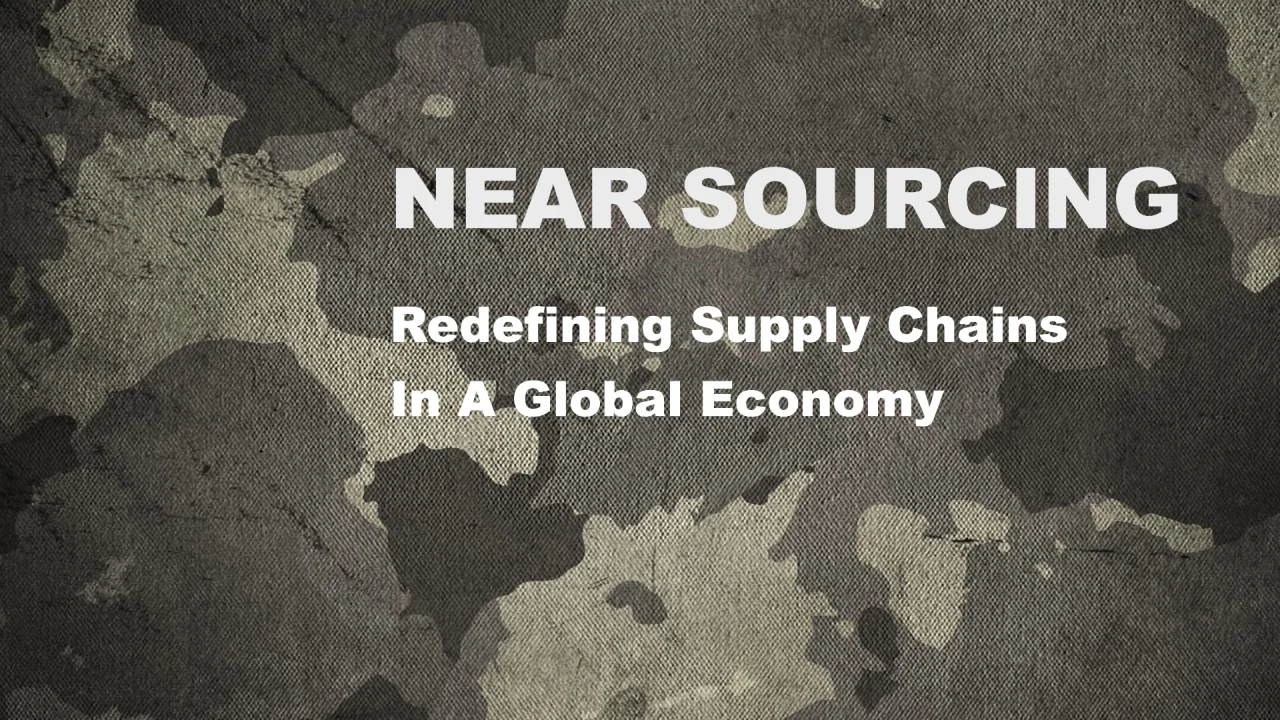Latest Posts
June 30, 2025 Tariffs: The Upside
June 30, 2025
Tariffs: The Upside
June 30, 2025
 Exploring the Role of Intrapreneurs: Innovation Drivers Within Organizations
June 30, 2025
Exploring the Role of Intrapreneurs: Innovation Drivers Within Organizations
June 30, 2025
 Mastering Productivity: A Guide to Being More Effective While Working from Home
Mastering Productivity: A Guide to Being More Effective While Working from Home
Newsletter
Sign up to receive email updates from the Freightpath.
"*" indicates required fields
Near Sourcing: Redefining Supply Chain Strategies in a Global Economy
June 16, 2024
In the realm of modern supply chain management, the concept of near sourcing has emerged as a pivotal strategy reshaping how businesses approach their procurement and manufacturing operations. Near sourcing represents a departure from traditional practices of offshoring and global outsourcing, advocating for closer geographic proximity between suppliers and consumers. Let’s explore the nuances of near sourcing, its benefits, challenges, and practical applications in today’s globalized economy.
Understanding Near Sourcing
Near sourcing refers to the strategic decision by companies to locate their supply chain activities closer to their primary markets or end consumers, typically within the same region or continent. Unlike offshoring, which involves outsourcing production to countries with lower labor costs overseas, near sourcing prioritizes proximity for enhanced operational efficiency, agility, and responsiveness to market demands. This approach aims to balance cost considerations with factors such as quality control, speed-to-market, and supply chain resilience.
Key Principles of Near Sourcing
- Proximity to Market: Near sourcing emphasizes geographic proximity between suppliers, manufacturers, and consumers. This closeness facilitates faster transportation times, reduced lead times, and lower shipping costs compared to distant offshore locations.
- Supply Chain Resilience: By minimizing supply chain length and complexity, near sourcing enhances resilience against disruptions such as natural disasters, geopolitical instability, and trade barriers. It allows companies to mitigate risks and maintain continuity in their operations more effectively.
- Quality Control and Compliance: Proximity enables tighter control over product quality, manufacturing processes, and regulatory compliance. Companies can enforce stringent standards and ensure adherence to local regulations, thereby enhancing product reliability and customer satisfaction.
- Cost Efficiency: While near sourcing may not always offer the lowest labor costs found in offshore locations, it can reduce overall supply chain costs by optimizing inventory management, transportation expenses, and inventory carrying costs.
- Environmental Sustainability: Near sourcing aligns with sustainability goals by reducing carbon emissions associated with long-distance transportation. It supports eco-friendly practices and promotes corporate social responsibility (CSR) initiatives within local communities.
Benefits of Near Sourcing
The adoption of near sourcing presents several strategic advantages for businesses operating in diverse industries:
- Improved Responsiveness: Closer proximity enables faster response times to changes in consumer demand, market trends, and supply chain disruptions. Companies can adjust production schedules, replenish inventory promptly, and capitalize on emerging opportunities more effectively.
- Enhanced Supply Chain Flexibility: Near sourcing facilitates greater flexibility in production planning and inventory management. Companies can adopt just-in-time (JIT) manufacturing practices, reduce inventory levels, and optimize warehouse operations to meet fluctuating market demands efficiently.
- Quality and Reliability: Proximity to suppliers fosters stronger relationships, transparent communication, and collaborative problem-solving. It ensures consistent product quality, adherence to specifications, and timely resolution of manufacturing issues.
- Cost Optimization: While labor costs may be higher than in offshore locations, near sourcing reduces expenses associated with inventory management, transportation, and import duties. It offers a balanced approach to cost optimization without compromising operational efficiency or product quality.
- Local Economic Impact: Near sourcing contributes to local economies by creating jobs, supporting small and medium-sized enterprises (SMEs), and fostering economic development in the regions where production occurs. It promotes community engagement and strengthens supply chain partnerships.
Practical Applications of Near Sourcing
Near sourcing strategies find practical application across various industries and business contexts:
- Automotive Industry: In the automotive sector, near sourcing facilitates the production of components and assemblies in close proximity to final assembly plants. This approach minimizes lead times, reduces transportation costs, and enhances supply chain agility to meet just-in-time manufacturing requirements.
- Consumer Electronics: In consumer electronics, near sourcing enables companies to manufacture devices and components closer to major consumer markets. It supports rapid product launches, customization options, and efficient after-sales service, thereby enhancing customer satisfaction and brand loyalty.
- Fashion and Apparel: In the fashion industry, near sourcing promotes ethical manufacturing practices, supports sustainable fashion initiatives, and ensures compliance with labor standards and environmental regulations. It enables brands to respond quickly to fashion trends, reduce excess inventory, and minimize fashion waste.
- Food and Beverage: In the food and beverage sector, near sourcing focuses on sourcing ingredients locally or regionally to ensure freshness, traceability, and compliance with food safety regulations. It supports farm-to-table initiatives, promotes local agriculture, and enhances supply chain transparency.
- Pharmaceuticals and Healthcare: In pharmaceuticals and healthcare, near sourcing emphasizes local production of pharmaceutical ingredients, medical devices, and healthcare products. It ensures supply chain security, regulatory compliance, and timely access to critical healthcare supplies during emergencies.
Challenges and Considerations
Despite its strategic advantages, near sourcing poses challenges that companies must address to optimize its implementation:
- Higher Labor Costs: Proximity to markets often involves higher labor costs compared to offshore locations with lower wage rates. Companies must evaluate cost differentials and implement efficiency measures to mitigate cost impacts.
- Supply Chain Complexity: Near sourcing requires robust logistics management, supply chain visibility, and coordination among multiple stakeholders. Companies need to invest in technology solutions, data analytics, and collaborative platforms to streamline operations and enhance supply chain transparency.
- Risk Management: While near sourcing enhances supply chain resilience, it also exposes companies to regional risks such as political instability, regulatory changes, and natural disasters. Effective risk management strategies, contingency planning, and diversification of suppliers are essential to mitigate potential disruptions.
- Cultural and Legal Considerations: Operating in diverse geographical regions necessitates understanding cultural norms, legal frameworks, and regulatory requirements. Companies must navigate cultural differences, language barriers, and compliance complexities to maintain ethical business practices and ensure legal compliance.
Future Trends and Outlook
The evolution of near sourcing is influenced by emerging trends and technological advancements shaping the future of supply chain management:
- Digital Transformation: Adoption of advanced technologies such as artificial intelligence (AI), Internet of Things (IoT), and blockchain enhances supply chain visibility, real-time data analytics, and predictive forecasting capabilities. It supports agile decision-making, reduces operational inefficiencies, and enhances collaboration across supply chain partners.
- Reshoring Initiatives: Increasing emphasis on domestic production and reshoring initiatives in response to geopolitical uncertainties, trade tensions, and supply chain vulnerabilities. Companies are reassessing their sourcing strategies to prioritize supply chain security, operational resilience, and national interests.
- Sustainability and ESG Factors: Growing emphasis on environmental sustainability, corporate social responsibility (CSR), and ethical sourcing practices drives companies to integrate sustainability criteria into near sourcing decisions. It promotes eco-friendly manufacturing practices, reduces carbon footprint, and enhances brand reputation among environmentally conscious consumers.
- Supply Chain Localization: Regionalization of supply chains and localization strategies to enhance supply chain resilience, minimize dependence on global suppliers, and optimize logistics networks. Companies are exploring opportunities to leverage regional advantages, support local economies, and mitigate risks associated with global supply chain disruptions.
Conclusion
In conclusion, near sourcing represents a strategic approach to supply chain management that prioritizes proximity, agility, and responsiveness in a globalized economy. By leveraging geographic proximity to markets, suppliers, and consumers, companies can achieve operational efficiency, mitigate risks, and enhance supply chain resilience. While near sourcing presents challenges related to cost, complexity, and risk management, its strategic benefits outweigh the potential drawbacks for organizations seeking to optimize their supply chain strategies. As businesses navigate evolving market dynamics, technological advancements, and sustainability imperatives, near sourcing will continue to shape the future of supply chain management and drive competitive advantage in the global marketplace.
CEO @ FreightPath Inc. | CSCMP Corporate Member | We Deploy The Industry’s Most Comprehensive Global Supply Chain Curriculum | 500+ Course Library | gofreightpath.com/course-catalog
